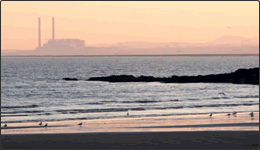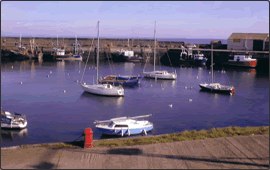It was not until the 1800s that the people of Cockenzie and Port Seton were of sufficient numbers and interest in religion to require a Church to be built. Up until then they were within the Parish of Tranent and some may have attended there.
A site for a Church on the High Street was obtained from Mr Cadell and the building constructed in the early 1830s. This Congregation gained Parochial status in 1838 with Rev Lorimer as minister. The disruption of 1843 to which the Rev Dr Thomas Chalmers was a significant contributor, saw the minister and most of the congregation leave the established Church to join the Free Church using their new building until 1850 when they were evicted. A second Church was built in School Lane in 1855 and this satisfied the needs of the congregation for forty years. The population during this period rose from less than 1000 to over 1600.
At a meeting of the congregation of the Free Kirk on 11 th September 1895 “it was resolved to instigate a movement towards building a new Church”. This was reported to the Deacons' Court on the 9 th November 1895 when the moderator, Rev W. Ogg, was requested to “lay the matter before Presbytery and to ask the Court to take the necessary steps to obtaining collecting books”. The next five years were very poor for the fishing and this was reflected in the concerns for the financial situation of the congregation which was trying to pay off the cost of the new manse, Aldersyde, built on the corner of Edinburgh Road and Manse Lane in 1890.
It was not until the turn of the century that the impetus for building the new Church was rekindled coinciding with the coming together of Churches to form the United Free Church. Mrs William Wood, nee Margaret Chalmers, daughter of Rev Thomas Chalmers, had been a great supporter of the new Church project and had given several donations towards its cost. Minutes of the Court of 3 rd March 1902 record a house to house collection raising £107.50p. Preliminary plans by a Mr P Whitecross were considered and adopted by the Court. At a meeting a fortnight later an alternative plan by Mr C Greig of Edinburgh was tabled and this was presented to the Presbytery Building Committee in May of that year. The Church fund then stood at £385.55p
In September 1903 the plan by Mr S Mitchell was resubmitted by Col. Cadell and it was “unanimously resolved to adopt this plan previously viewed in July 1903 on the basis that it was less costly and provided more seating than the alternatives and conditional that “the estimate of £2,500.00 shall not be exceeded”. Col. Cadell was instructed to communicate this to the architect and it was agreed to submit this to a congregational meeting the following day.
Up until this time efforts had been ongoing to obtain a site for the new building with the preferred option one within the walled grounds of Mr Hunter's property, Winton Lodge. This was near to the manse and the only occupied site on the south side of Edinburgh Road from Lorimer Place incidentally named after the minister of the Church at the time of the disruption.
A site, however, was offered by Lord Wemyss on the south side of Edinburgh Road , immediately opposite Manse Lane , at a cost of £30 per acre. The Deacons' Court agreed to purchase 1/4 of an acre for the new building. 
Estimates were obtained, a tender accepted and during December the contractor began erecting his huts on site. Unfortunately formal approval of the Presbytery of Haddington and Dunbar Church and Manse Building Committee had not been received. This required an urgent trip by the minister to Edinburgh to resolve the difficulty directly with the United Free Presbytery headquarters.
The original design by Sidney Mitchell was for a simple rectangular building with twin towers. The stone side walls were very low and the pitched roof windows echoed the buildings in Gosford Road in style and scale. Major design changes followed through the construction of the building and included moving the vestry and its entrance outside the rectangle. A gallery was then added and a single stair tower replaced the twin towers on the original drawings. The gallery changed the geometry of the building and the walls had to be heightened to accommodate this new first floor and the pitched dormers changed to flat ones. The tower room, or committee room, was then added which increased the width of the tower to what we now have with its elegant slated hexagonal spire.
Grace Wood laid the foundation stone on 13 th February 1904 and building continued for a further twelve months. During this time the seating capacity of the building was considered too small for the increasing population of the villages and the anticipated influx of miners to work the Prestongrange and Prestonlinks mines. An urgent request was sent out for money to add a further 77 seats. This was approved by Presbytery and the transept was added to the design making the overall seating capacity of the building 620 at a cost of £3,000 while the congregation then numbered 200. Although this was disputed by Presbytery who calculated the seating capacity at 585 persons.
 The first service in the completed building was held on 1 st April 1905. The first service in the completed building was held on 1 st April 1905.
The Church building is virtually as it was on opening day with many of the original features still in use. The positions of the pulpit and choir have changed and the heating, lighting and organ upgraded over the years. The building is deservedly in the highest category of preservation listing. The building was referred to as the United Free Kirk, adopting the title Chalmers Memorial at the time of union in 1929. A site to the west of the Church was purchased for the building of a hall and this was started in 1953 with the foundation stone being laid by Miss Cadell 50 years to the day after the Church stone in February 1954 by Marion Cadell. The design was by Robert Naismith, a member of the congregation, and was recognised by a commendation from the planning authority. A large effort of voluntary labour by members of the congregation kept the cost to less than £10,000 and the building was opened in September 1957.
MINISTERS |
YEARS |
Archibald Lorimer |
1838-1869 |
James Kilgour |
1870-1887 |
William Hogg |
1888-1907 |
Edward J Hagan |
1907-1911 |
Robert B Hastie |
1911-1919 |
Robert Howie |
1919-1931 |
Robert R Watt |
1931-1935 |
George T H Reid |
1935-1938 |
Thomas J Dyer |
1939-1942 |
Henry B Lawson |
1942-1951 |
Robert Brownlee |
1951-1957 |
David L Wright |
1957-1964 |
Geoffrey H Underwood |
1964-1992 |
Ian Wiseman |
1993-1995 |
Robert L Glover |
1997-2010 |
Kristina Herbold Ross |
2011 - 2016 |
Robin N Allison |
2018 - |
|













 The first service in the completed building was held on 1 st April 1905.
The first service in the completed building was held on 1 st April 1905. 